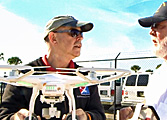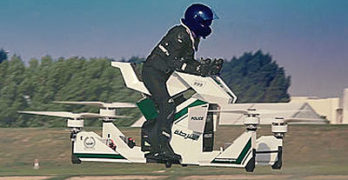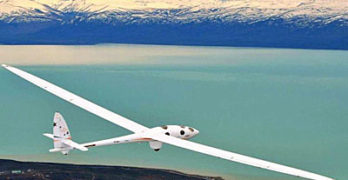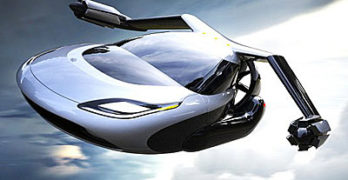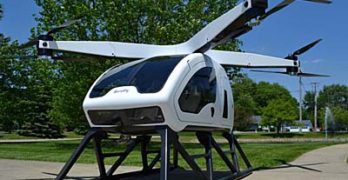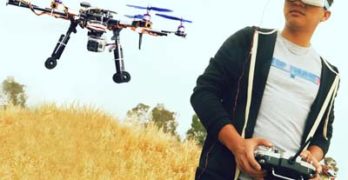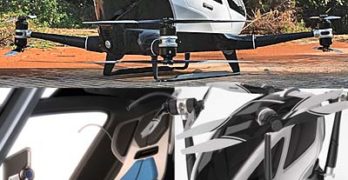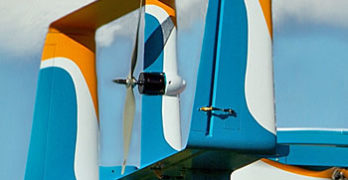Lately the loud buzz in aviation is drones. Called UAVs, UASs, RPVs or other names, we’ll just use “drone.” Not our usual fare of reports on man-flown aircraft, we are just as intrigued as tens of thousands of others with this camera-carrying airplanes. They are radio-controlled (RC) but with autonomous flying capability should you lose radio contact or if some other interference happens. Come with us as we fly and witness the surprisingly smooth flight of the DJI drone.
Search Results for : quadcopter
Not finding exactly what you expected? Try our advanced search option.
Select a manufacturer to go straight to all our content about that manufacturer.
Select an aircraft model to go straight to all our content about that model.
Air Taxi or Air Funster? — 5 Models in Development, as Part 103 Multicopters Not Taxis
If you listen to perpetually-excited media, air taxis will soon be shuttling people hither and yon in all the big cities of the globe. Executives and shoppers will be whisked around downtown skyscrapers silently, quietly, swiftly, and the cost will be modest. Do you buy all that? I’m not holding my breath.
Oh, these air taxi vehicles are coming. I don’t doubt that, if for no other reason than they are absorbing vast amounts of money as people bet on some grand future where infotech merges with aviation to make flying vastly better and easier. It’s a fantastic dream and when smart people powered by enough money work on something long enough… something often happens.
Fine. That’s the sales pitch and apparently it’s working because more than 350 companies around the globe have raised billions of dollars to pursue their dreams yet the first entries remain far from market.
Several people at the very pinnacle of FAA have departed the agency and are now working for air taxi developers (naturally, they are often called by some term other than the mundane “air taxi” label).
April Foolin’? Are You Ready for Hoverbiking on Scorpion 3?
After you finish Easter Sunday dinner with the family, how about going out for a spin on your new Scorpion 3 Hoverbike? Is this merely an April fools joke?
Apparently not. Video appears to prove this machine, though with the state of the art in digital effects, anything you see can be fiction.
As many of us prepare for the start of Sun ‘n Fun 2018 in barely over one week, we hope to see numerous flying machines of interest. My visual partner, Videoman Dave and I will be onsite in Lakeland, Florida — and the following week at Aero Friedrichshafen in the south of Germany. Our mission is to collect a large batch of video that we hope will educate and entertain enthusiasts of light aviation.
I do not expect we will be covering Scorpion 3, but I have to admit I found the idea fascinating.
Strange Aviation Bedfellows? …Airbus, BRS Parachutes, Boeing and Batteries
Is your aviation horizon is getting confused by quadcopters, electric aircraft, and airliners?
What’s going on, anyway? Airbus supporting a glider? BRS building emergency parachutes for an aircraft hoping to fly to 90,000 feet, on the edge of space? Boeing investing in a battery start-up?
What will flying become in the future? This is impossible to know but here’s something to think about: If “Beam-me-up, Scotty” technology ever arrives, airlines may disappear quickly. Sport aircraft, however, should survive because they are flown to experience joy aloft, not for transport. Meanwhile…
Battle of the Giants
Progress toward new aviation frontiers continues. Airbus has generated media attention for several out-of-the-box projects they are supporting. Pursuing new directions may lead to an electric propulsion airliner of the future. Only time knows how that may turn out, but meanwhile companies from our sector of aviation are making some inroads to these new developments.
China’s Geely, Owner of Volvo, Acquires Terrafugia’s Light-Sport Aircraft Transition
In a familiar theme, a Chinese company has acquired an American aircraft company. Past purchases include Cirrus Design, Mooney, Glasair, and Continental Motors, among others.
This time news reports say a Chinese company bought a company from the light aircraft space: Terrafugia, maker of the Transition flying car, or as they prefer to call it, a roadable aircraft.
Geely is an automaker based in Hong Kong that bought the famed Swedish car maker, Volvo.
The Massachusetts airplane developer has put out slick video presentations of their newer-still model, the TF-X, a hybrid electric variation (video at bottom). I suspect it is this newer entry that has both automobile makers excited.
Terrafugia first announced their Transition roadable airplane in 2006, flying a proof-of-concept aircraft in 2009 along with a demonstration before attendees of EAA AirVenture Oshkosh in 2013. The Massachusetts company built a second-generation Transition prototype in 2012.
Your “Light-Sport” Quad Awaits, and It’s Affordable (kinda, sorta)
Update: Unknown at the time this article was posted, Viking Aircraft Engines reports it provides the powerplant for SureFly. —DJ July 5, 2017
News from the Paris Air Show probably does not interest you too much, unless you care about the airliner you will fly in eight years from now. However, one article caught my interest because of a few references. (The article I found is available here.)
Here’s the parts that grabbed me:
(1) “We’re hoping it can be a light-sport aircraft type of licence,” said developing company CEO Steve Burns. “We want to keep it minimal, and we believe it’s easy enough to fly to do that.”
(2) It will be pilot-operated; controls are said to be minimal, with buttons for up/down altitude adjustment, and a joystick for forward, sideways and yaw.
(3) The company aims to bring the SureFly to market at a price of just $200,000.
The Future of Flying… Could It Happen?
Two forms of flying are racing at us at increasing speed. This is both scary and promising at once. What can we expect? My crystal ball is no better than yours, but let me tell you what I can imagine may be headed our way.
I refer to two generally unrelated activities in the air: autonomous aircraft and FPV drones. Most pilots to whom I’ve spoken seem intrigued by these innovations and a few are enjoying their quadcopters, myself included.
Others are not so sure if they like the idea of either unmanned but man-carrying aircraft or a swarm of drones buzzing about the airport or neighborhood. I understand this viewpoint. Most of us treasure our privacy and don’t want it invaded.
Yet I invite you consider the following scenario… perhaps 3-10 years in the future.
Think about why you like recreational flying, in your LSA, light kit, or ultralight.
Cruzer Prepared for FAA Kit Evaluation Team
Even very familiar companies like Zenith Aircraft company, part of a family light aviation empire including Zenair in Canada•, has to prepare well when FAA comes to visit. Specifically, this would be the agency’s KET or Kit Evaluation Team. When various representatives of the regulatory agency visit they use a multi-page list to assure that a kit aircraft meets the requirement that 51% of the kit is built by the owner.
Formerly called Experimental Amateur Built (or EAB), many aviators simply say the “51% rule.” In earlier times, kit aircraft were scratch built — meaning a builder secured raw materials that had to be formed and finished while referring to drawings, a potentially very lengthy process. To ease the effort and increase sales, an industry developed to sell component kits. These have become increasingly sophisticated with qualities such as match-hole construction using CNC machines.
Making it easier for a builder to assemble his or her aircraft is good, but the kit manufacturer must be able to clearly demonstrate how the owner will do 51% of the work, as required.
Is the Future of Flight Autonomous?
As techies know the giant Consumer Electronics Show (CES) has been in the news over the last week and we’ve seen articles about cool stuff at the event. I don’t remember ever seeing anything about manned aircraft in CES coverage before though quadcopters have had a clear presence. At the 2016 event, though, one vehicle got a lot of attention: eHang 184, from China. You can check out their video below.
I found eHang very intriguing but I hesitate to call it an aircraft, at least compared to manned airplanes. It is more like an autonomous air vehicle and I say that because the occupant is not a pilot. As its developers tell the story, you get in, use the screen in front of you to tap where you want to go and eHang flies you to that destination. I’d be more likely to call it an “aircab.”
As currently portrayed and as seen at CES, eHang is something very different.
FAA’s Billion-Dollar Problem (Hint: Drones)
I realize that for some readers I may be swimming upstream when I write about drones (or UAVs or RPVs, or whatever). First, many of you simply don’t care; your passion is for manned flight and I completely understand. Second, some of you see real danger to your manned flying due to a growing drone population. Those who guess the future think more than a million units will be sold this holiday season. Third, we have the matter of privacy. Probably like you, I don’t like the idea of some government agency or even a snoopy neighbor being able to peer into my yard against my preference.
This article presents a somewhat different, somewhat nuanced view of drone development and the reasons are financial, which may not be how you’ve seen this issue. Consider that FAA is — compared to most aviation businesses — an absolutely enormous organization. It has an annual budget of more than $15 billion and around 50,000 employees.


